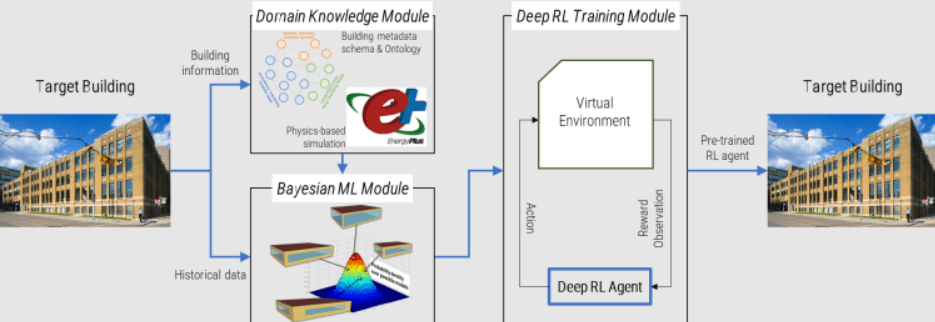TL;DR:
- Seungjae Lee’s Grid-Interactive Smart Campus Buildings project leverages AI to optimize heating and cooling systems in existing buildings.
- The project aims to reduce the University of Toronto’s climate footprint by utilizing AI solutions in building science.
- A digital twin of the Exam Centre is being created as a virtual representation for further development and optimization.
- A deep reinforcement learning algorithm will be developed for optimal control of heating and cooling systems, pre-trained using data from the digital twin.
- Lee’s research focuses on understanding human interactions with buildings through causal relations to develop intelligent and human-centric solutions.
- Collaboration with PLC Group aims to develop a scalable digital twinning tool for building energy systems.
- The use of AI in building management systems can significantly improve sustainability and enhance the way we interact with our built environment.
Main AI News:
In the quest for energy efficiency, we often focus on simple actions like turning off lights when we leave a room. But what about the larger systems that consume vast amounts of energy in our buildings, like the furnace or air conditioning? Seungjae Lee, an assistant professor at the University of Toronto’s Department of civil and mineral engineering, believes that artificial intelligence (AI) holds the key to optimizing these systems and paving the way for a more sustainable future.
Lee’s latest endeavor, the Grid-Interactive Smart Campus Buildings project, is a three-year pilot initiative aimed at reducing the University of Toronto’s climate footprint. By harnessing the power of AI, the project seeks to optimize the heating and cooling systems in existing buildings. Working in collaboration with Chi-Guhn Lee, a professor in the Department of mineral and industrial engineering, this innovative project is jointly funded by the Climate Positive Energy and Climate Positive Campus initiatives at the university.
Buildings are responsible for a staggering 25 to 30 percent of total energy consumption and greenhouse gas emissions in Canada and worldwide, according to Lee. Considering that people spend approximately 90 percent of their lives indoors, it becomes crucial to ensure comfortable and healthy indoor environments. However, there is a pressing need to be smarter about utilizing our available resources.
Lee’s research delves into the realm of AI solutions applied to building science, addressing this urgent issue. In the initial phase of the project, the team is focused on creating a digital twin—a virtual replica—of the Exam Centre at 255 McCaul St. This digital twin will serve as a platform for further development and optimization.
In subsequent stages, the researchers will develop a cutting-edge deep reinforcement learning algorithm that enables optimal control of heating and cooling systems. To avoid imposing excessive stress on the actual building, this algorithm will be pre-trained using data from the digital twin. Once refined, the algorithm will be implemented in the real Exam Centre and fine-tuned through interactions with the building itself. If successful, Lee envisions applying this approach to convert more campus buildings into smart buildings, thus contributing to the university’s Low-Carbon Action Plan.
An astonishing 60 percent of the St. George campus’s energy consumption is attributed to heating and cooling buildings, as highlighted by Lee. To complement this research, Lee’s group is also engaged in a project funded by NSERC Discovery, focusing on scalable systems for intelligent and interactive buildings. This area of study is relatively unexplored, but Lee aims to change that by investigating how humans interact with their buildings.
Unlike previous methods that relied on correlational data between thermostat settings and other parameters, Lee and his team are pioneering the use of causal relations. By understanding the factors that influence occupants’ decision-making regarding thermostat settings, they aim to develop reliable and human-centric smart solutions. Lee emphasizes that understanding causation will unlock the potential for creating more intelligent and interactive buildings.
While Lee is not the only researcher exploring the application of machine learning and AI techniques in the building sector, progress has been slower compared to industries like automotive or health care. The unique energy consumption profiles and diverse needs of individual buildings have presented significant challenges.
Solutions tailored for one building may not necessarily be transferrable to another, impeding the advancement of smarter buildings. To overcome this roadblock, Lee’s team has partnered with PLC Group and secured funding from the Ontario Centre of Innovation to develop a scalable digital twinning tool for building energy systems. If successful, this tool will equip the building industry with the means to create intelligent, interactive, and sustainable buildings worldwide.
Lee believes that AI integration in building management systems has the potential not only to enhance the sustainability of our built environment but also to revolutionize the way we interact with it. The future holds tremendous promise, where AI empowers us to create energy-efficient spaces that harmonize with our needs and aspirations.

This schematic describes how deep learning could be used to create customized algorithms for optimizing energy use in buildings (illustration by Seungjae Lee). Source: UNIVERSITY OF TORONTO
Conclusion:
The integration of AI technologies in building efficiency holds immense potential for the market. Seungjae Lee’s pioneering research in the Grid-Interactive Smart Campus Buildings project demonstrates how AI can optimize heating and cooling systems, reduce energy consumption, and contribute to sustainability goals. This advancement opens up new opportunities for businesses in the building management sector to develop intelligent, scalable, and eco-friendly solutions. As the market evolves, the fusion of AI and building science will revolutionize the way we design, construct, and interact with buildings, creating a more sustainable and comfortable future for all.

